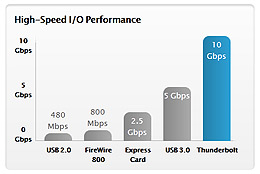Desktop RAIDs Just Got a Lot More Powerful
Apple’s Thunderbolt tech demo is certainly drool-inducing for video editors. In New York City last month, Apple reps were in show-off mode. A MacBook Pro running Final Cut was connected via a single, slender Thunderbolt cable to a four-drive desktop RAID system from Promise Technologies, which was, in turn, connected via Thunderbolt to a HDTV for playback. The demo artist layered up four streams of uncompressed HD on the Final Cut timeline and played them back from the RAID in real time, using the same connection for HD monitoring without breaking a sweat. Sleek and streamlined, the set-up seems to hugely expand the performance an editor can extract in a notebook-computing environment.
The tech specs are impressive. Thunderbolt is a dual-protocol technology that combines PCI Express and DisplayPort in a single connection, with full backward compatibility to existing DisplayPort devices. It has two bidirectional channels with 10 Gbps of bandwidth on each channel. (Apple was keen to point out the theoretical potential for a total of 40 Gbps of throughput in both directions under ideal conditions, but acknowledged that the technology is spec’d by Intel at 10 Gbps.) Each Thunderbolt peripheral will have an input and an output to support daisy-chaining up to six devices, according to Apple. Apple’s initial implementation of Thunderbolt uses copper-wire cables limited to three meters in length; an eventual fibre version will offer longer runs and more bandwidth.
Apple will need a little help from its friends in the storage industry to make Thunderbolt a success. At the February 24 launch of the new MacBooks, there were precisely zero storage peripherals available to support the new technology. PROMISE Technology said its new Pegasus four-bay and six-bay RAID enclosures will be available through Apple and other resellers in the second quarter, with pricing still to be announced. And LaCie announced a Thunderbolt version of its Little Big Disk with availability “by summer 2011.” Thunderbolt support is also coming from AJA, Avid, and Blackmagic, Intel said, tantalizingly, in a February 24 press release.
Apple doesn’t always back the right horse (remember its enthusiastic early embrace of DVD-RAM?), but Thunderbolt has a lot of potential to make content creators more mobile than ever. Expect to hear a lot more about Thunderbolt at NAB, particularly if Apple decides to make some cool Thunderbolt tricks (like video capture) part of its expected roll-out of a new, overhauled Final Cut Studio at the show. Apple’s reps stressed to me Thunderbolt’s basis in PCI Express technology – meaning, theoretically, anything you can do over PCI Express you can do with Thunderbolt. That means Gigabit Ethernet and Fibre Channel networks aren’t off-limits, and you have to wonder if 3G HD SDI over Thunderbolt is in our future.
For more information: www.apple.com/thunderbolt/
Sections: Technology
Did you enjoy this article? Sign up to receive the StudioDaily Fix eletter containing the latest stories, including news, videos, interviews, reviews and more.
